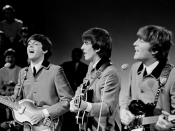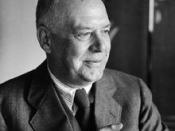The title of Wallace Stevens poem, "Thirteen Ways of Looking at a Blackbird," is misleading, because he does not only offer thirteen ways of looking at blackbird, but the poem offers us many insights on how humans think. "Blackbird", written by Paul McCartney and John Lennon, has many similarities with "Thirteen Ways of Looking at A Blackbird" other than just their titles. They use many poetic conventions to explain their poem's ideas, both writers use a blackbird to compare to humans and human nature, and imagery plays a big role in getting across their points.
Sometimes poets use different conventions to give the poem a better "flow." "Thirteen Ways of Looking at a Blackbird", by Wallace Stevens uses assonance to make the poem have a better sound or to give it a better "flow." Assonance is the repetition of vowels with different consonants. An example is stanza three of Steven's poem:
The blackbird whirled in the autumn winds.
It was a small part of the pantomime.
In the first line, "i" is repeated four times in blackbird, whirled, in, and winds. In the second line, "a" is also repeated four times in was, small, part, and pantomime. McCartney's and Lennon's song "Blackbird" uses anaphoras, which are repeated phrases at the beginning of a verse, throughout the poem. "Blackbird singing in the dead of night," and "you were only waiting for this moment to..." are the two most obvious anaphoras used. As a reader of the poem, these repeated lines stand out and grab the reader's attention. When finished with the poem, these lines will be the ones that stick with the reader. "Blackbird" also uses end rhyme and half rhyme, unlike Steven's poem. An example of the end rhyme used in the lyrics:
Take these sunken...



Good essay in need of revision.
This essay has alot of good points, but is not well organized. There are many instances in this essay of unfinished thoughts. There are many insightful observations made, but lacks explanation.
0 out of 0 people found this comment useful.